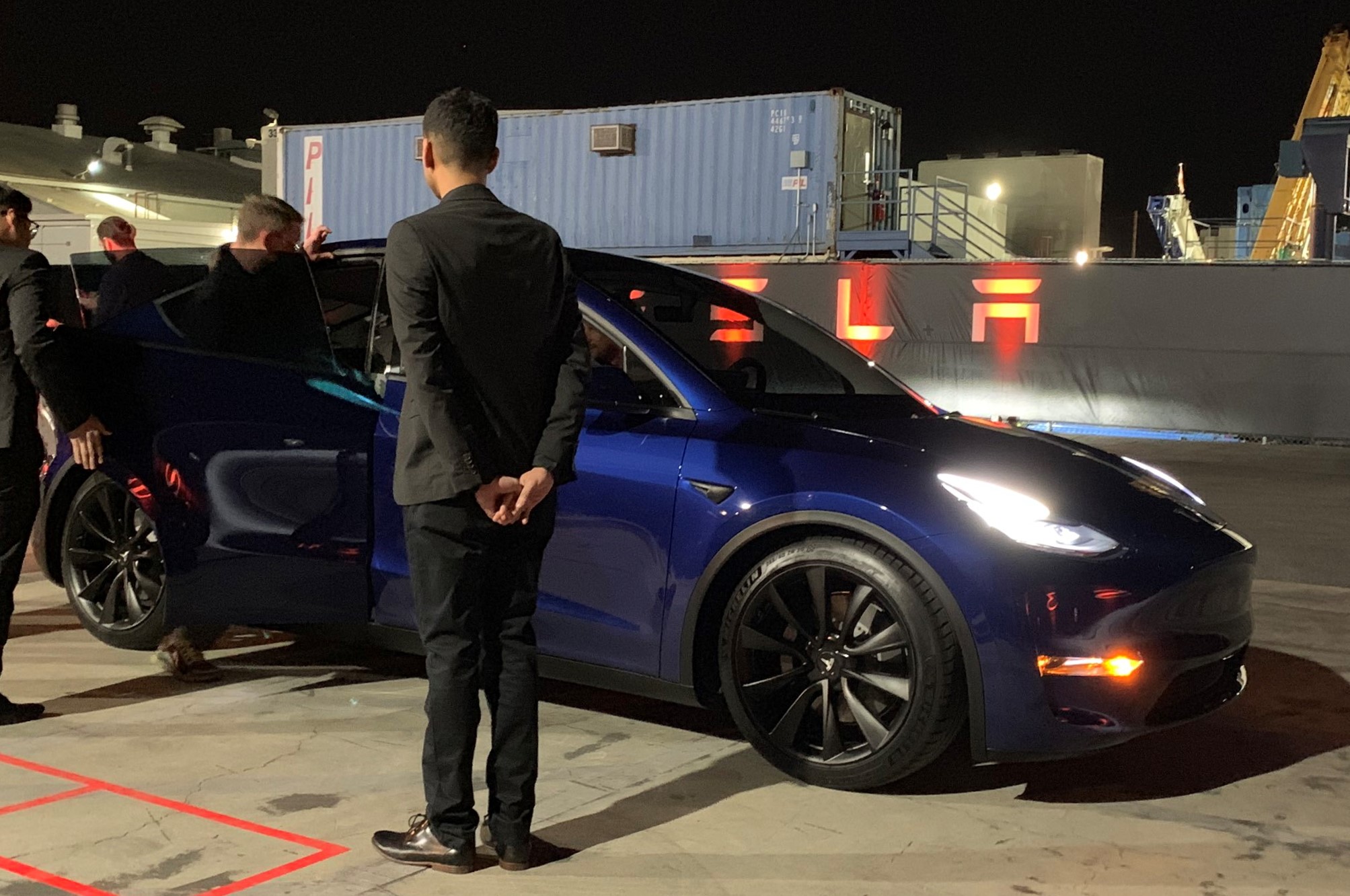
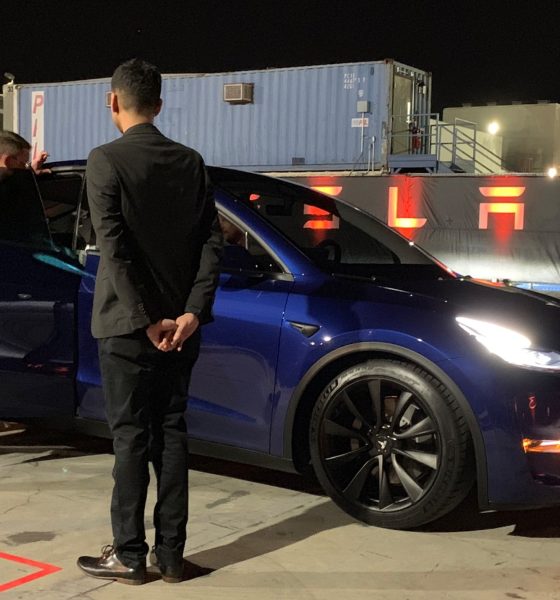
News
Tesla Model Y test ride: first impressions of Tesla’s latest 7-seat SUV (VIDEO)
Tesla has unveiled the Model Y, a seven-seater, 300-mile, all-electric SUV that is expected to be even more popular than the Model 3. Similar to the Model 3 unveiling, Tesla offered test rides in the Model Y after the event. Teslarati was able to acquire a slot for the SUV’s test rides.
Here’s how the test ride went.
Elon Musk has already stated that the SUV shares around 75% of its components with the electric sedan. From the exterior to the interior of the Model Y, it is evident that the vehicle is derived from its sedan sibling. The exterior is pretty much a bulkier version of the Model 3, while the interior shares the 3’s sleek dashboard that’s dominated by a 15″ touchscreen. The vehicle is pretty roomy too, as the test driver was around 6’2″ and there was ample headroom.

A look at the rear of the vehicle shows some classic Tesla cues. The second-row seats could seat three, and similar to Tesla’s other electric cars, there is ample legroom. The third-row seats, which can accommodate two, were folded down during the test drive. It remains to be seen how comfortable the third-row seats would be for adults, though considering the space on the vehicle, the last row could prove to be a pretty tight fit. Perhaps the Model Y’s third-row seats could serve a similar purpose as the Model S’ rear-facing jump seats, which are optimized for children.
The ride itself is very characteristic of Tesla, being quiet and smooth. The car seems to handle just like the Model 3, as it was nimble and responsive to the driver’s input. The iconic Tesla acceleration was there, thanks to the test unit’s dual motor AWD configuration. There was also very little body roll despite some spirited driving maneuvers. Based on how the Model Y handled imperfections on the road, the vehicle seemed like it was equipped with coil springs, similar to the Model 3.
Particularly notable is how well the Panoramic glass roof worked with the Model Y’s SUV form factor, allowing a full, unobstructed view of the sky. It should be noted that the glass roof does not have a center cross member such as the one found in the Model 3, effectively making the Model Y’s glass roof arguably the most stunning in Tesla’s lineup. Teslarati was told that this would make it to production.

The Model Y was pretty much what the Tesla community expected. It might not have too many bells and whistles (the glass roof is amazing though) but it represents a notable balance between features and practicality. Tesla would likely not run into production issues with the Model Y, thanks to its similarities with the Model 3 and the lessons the company learned from its past production ramps. At this point in Tesla’s history, the Model Y is a perfect vehicle to release, as it is reasonably-priced, and perhaps most importantly, not too difficult to produce.
The Model Y comes in four variants: the Standard Range, Long Range, Dual Motor AWD, and Performance versions. The Standard Range version is capable of going 230 miles on one charge, while the Long Range version goes 300 miles per charge. Both the Dual Motor AWD and Performance Model Y get 280 miles between charges.
The Model Y will enter production in Fall 2020, with Tesla producing the Standard Range version in Spring 2021. The Model Y starts at $39,000 for the Standard Range version and $47,000 for the Long Range variant. The Dual Motor AWD costs $51,000, and a Performance version will be priced at $60,000.
Watch Teslarati‘s test ride in the Model Y in the video below.

News
Tesla is improving Giga Berlin’s free “Giga Train” service for employees
With this initiative, Tesla aims to boost the number of Gigafactory Berlin employees commuting by rail while keeping the shuttle free for all riders.
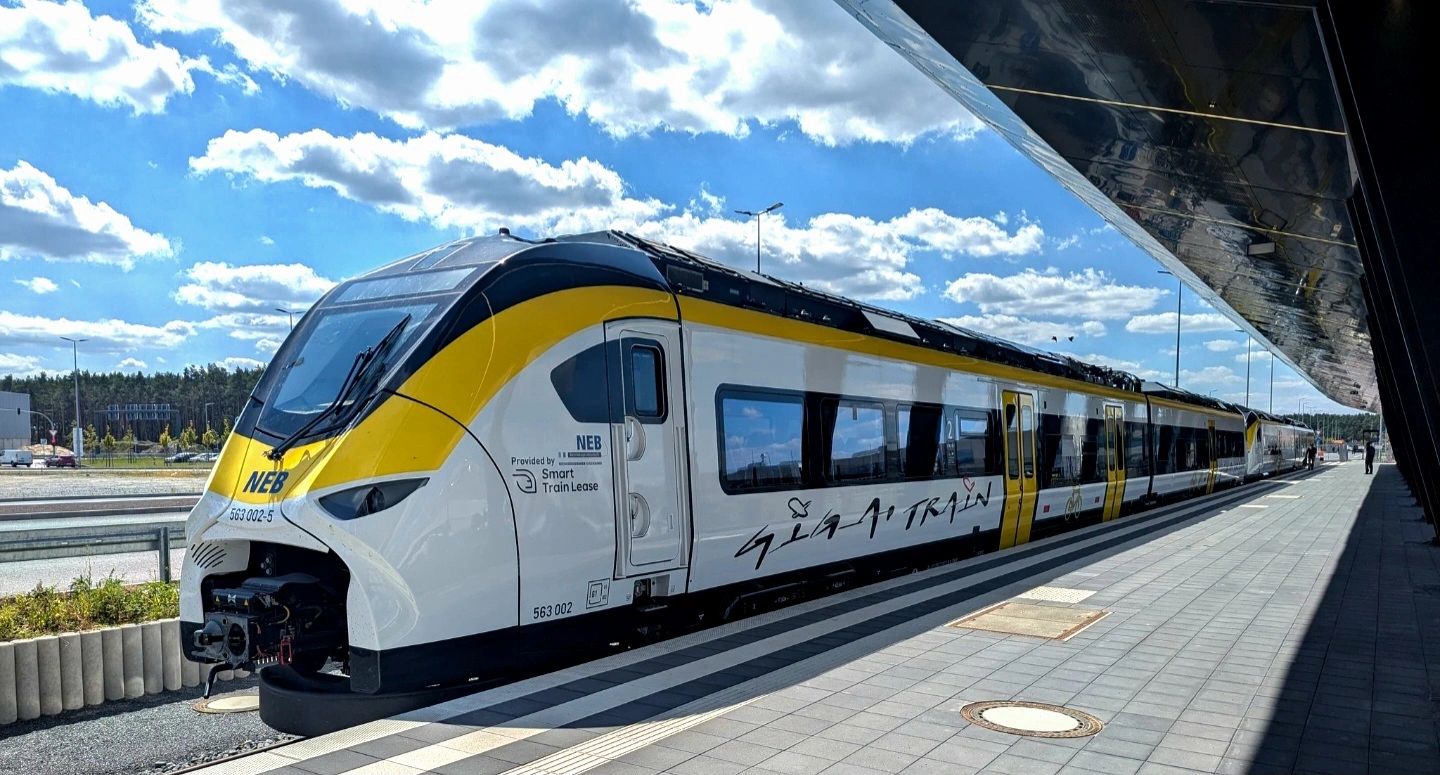
Tesla will expand its factory shuttle service in Germany beginning January 4, adding direct rail trips from Berlin Ostbahnhof to Giga Berlin-Brandenburg in Grünheide.
With this initiative, Tesla aims to boost the number of Gigafactory Berlin employees commuting by rail while keeping the shuttle free for all riders.
New shuttle route
As noted in a report from rbb24, the updated service, which will start January 4, will run between the Berlin Ostbahnhof East Station and the Erkner Station at the Gigafactory Berlin complex. Tesla stated that the timetable mirrors shift changes for the facility’s employees, and similar to before, the service will be completely free. The train will offer six direct trips per day as well.
“The service includes six daily trips, which also cover our shift times. The trains will run between Berlin Ostbahnhof (with a stop at Ostkreuz) and Erkner station to the Gigafactory,” Tesla Germany stated.
Even with construction continuing at Fangschleuse and Köpenick stations, the company said the route has been optimized to maintain a predictable 35-minute travel time. The update follows earlier phases of Tesla’s “Giga Train” program, which initially connected Erkner to the factory grounds before expanding to Berlin-Lichtenberg.
Tesla pushes for majority rail commuting
Tesla began production at Grünheide in March 2022, and the factory’s workforce has since grown to around 11,500 employees, with an estimated 60% commuting from Berlin. The facility produces the Model Y, Tesla’s best-selling vehicle, for both Germany and other territories.
The company has repeatedly emphasized its goal of having more than half its staff use public transportation rather than cars, positioning the shuttle as a key part of that initiative. In keeping with the factory’s sustainability focus, Tesla continues to allow even non-employees to ride the shuttle free of charge, making it a broader mobility option for the area.
News
Tesla Model 3 and Model Y dominate China’s real-world efficiency tests
The Tesla Model 3 posted 20.8 kWh/100 km while the Model Y followed closely at 21.8 kWh/100 km.
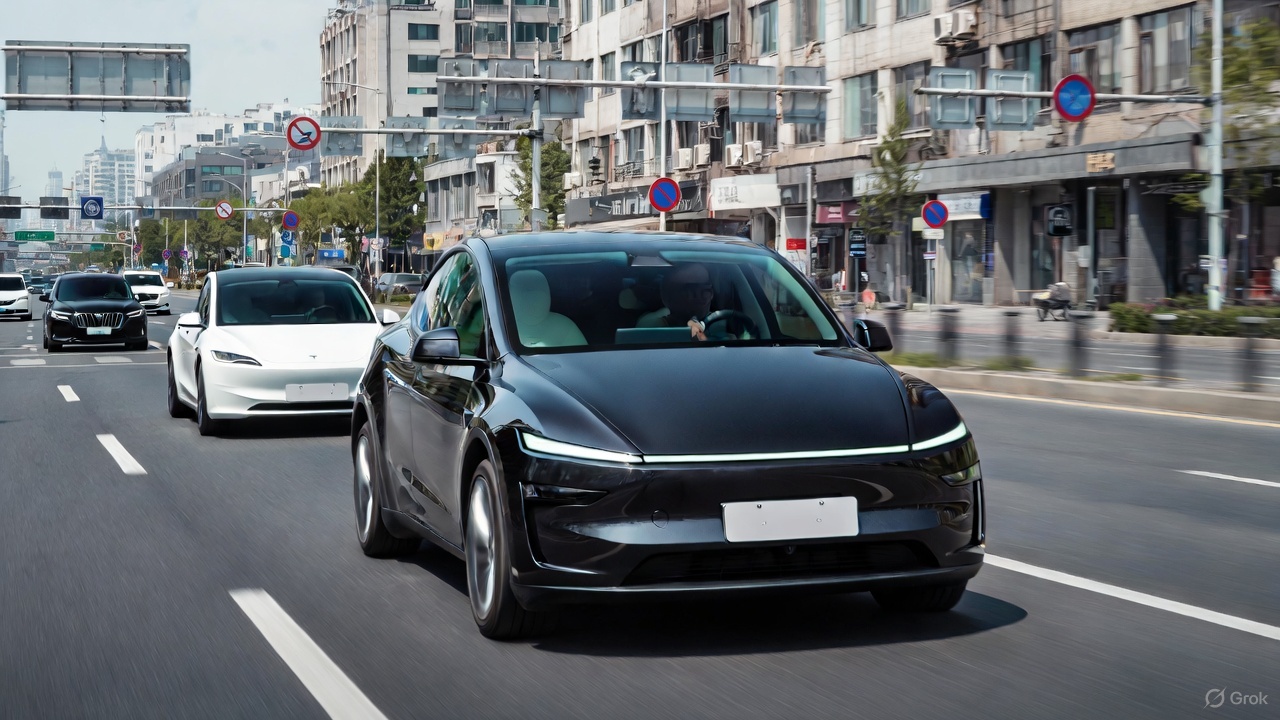
Tesla’s Model 3 and Model Y once again led the field in a new real-world energy-consumption test conducted by China’s Autohome, outperforming numerous rival electric vehicles in controlled conditions.
The results, which placed both Teslas in the top two spots, prompted Xiaomi CEO Lei Jun to acknowledge Tesla’s efficiency advantage while noting that his company’s vehicles will continue refining its own models to close the gap.
Tesla secures top efficiency results
Autohome’s evaluation placed all vehicles under identical conditions, such as a full 375-kg load, cabin temperature fixed at 24°C on automatic climate control, and a steady cruising speed of 120 km/h. In this environment, the Tesla Model 3 posted 20.8 kWh/100 km while the Model Y followed closely at 21.8 kWh/100 km, as noted in a Sina News report.
These figures positioned Tesla’s vehicles firmly at the top of the ranking and highlighted their continued leadership in long-range efficiency. The test also highlighted how drivetrain optimization, software management, and aerodynamic profiles remain key differentiators in high-speed, cold-weather scenarios where many electric cars struggle to maintain low consumption.
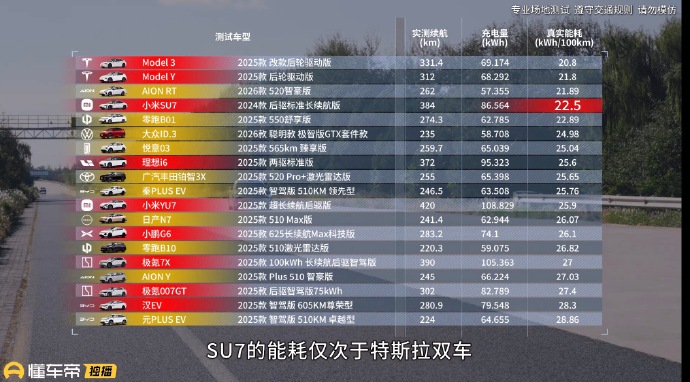
Xiaomi’s Lei Jun pledges to continue learning from Tesla
Following the results, Xiaomi CEO Lei Jun noted that the Xiaomi SU7 actually performed well overall but naturally consumed more energy due to its larger C-segment footprint and higher specification. He reiterated that factors such as size and weight contributed to the difference in real-world consumption compared to Tesla. Still, the executive noted that Xiaomi will continue to learn from the veteran EV maker.
“The Xiaomi SU7’s energy consumption performance is also very good; you can take a closer look. The fact that its test results are weaker than Tesla’s is partly due to objective reasons: the Xiaomi SU7 is a C-segment car, larger and with higher specifications, making it heavier and naturally increasing energy consumption. Of course, we will continue to learn from Tesla and further optimize its energy consumption performance!” Lei Jun wrote in a post on Weibo.
Lei Jun has repeatedly described Tesla as the global benchmark for EV efficiency, previously stating that Xiaomi may require three to five years to match its leadership. He has also been very supportive of FSD, even testing the system in the United States.
Elon Musk
Elon Musk reveals what will make Optimus’ ridiculous production targets feasible
Musk recent post suggests that Tesla has a plan to attain Optimus’ production goals.
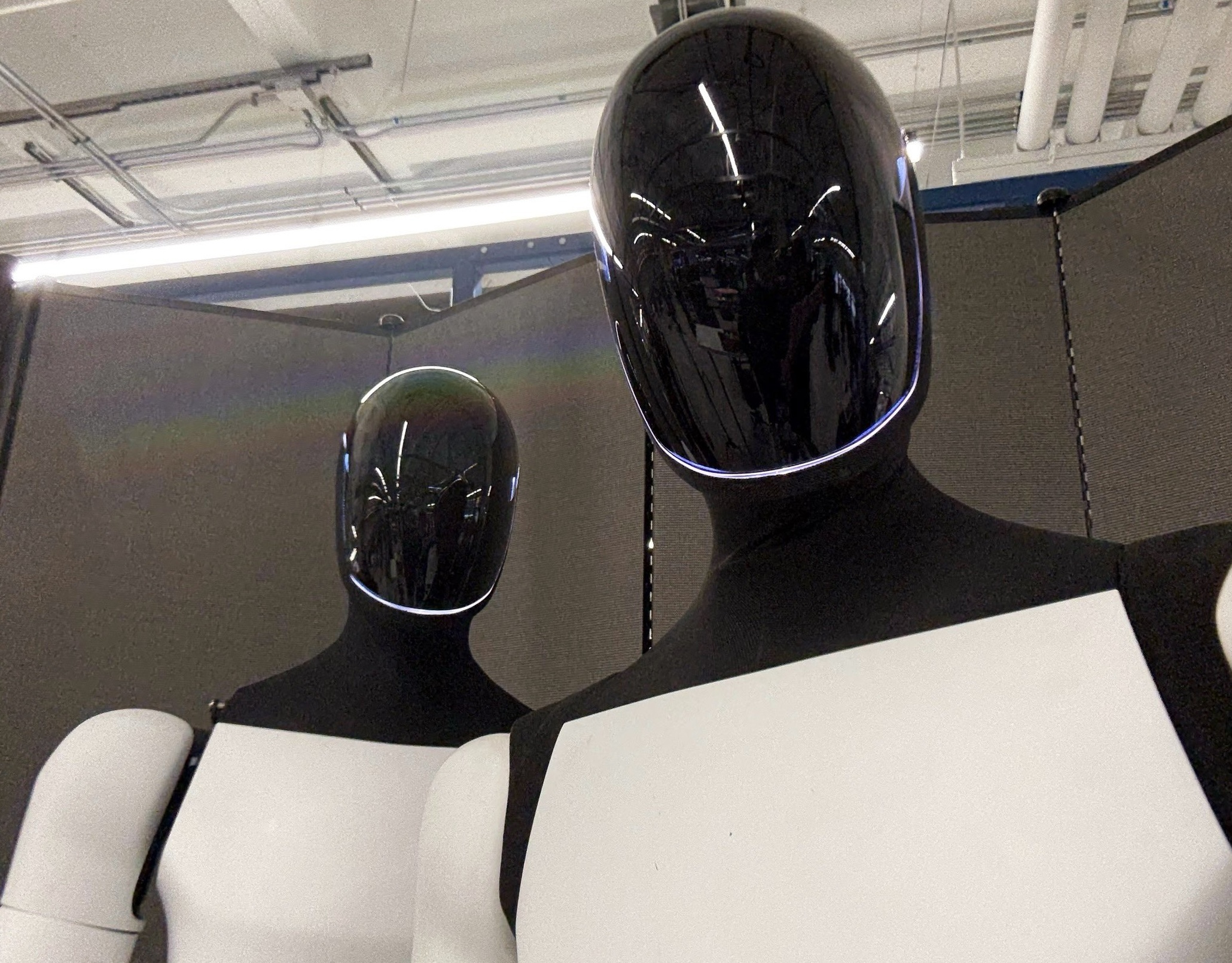
Elon Musk subtly teased Tesla’s strategy to achieve Optimus’ insane production volume targets. The CEO has shared his predictions about Optimus’ volume, and they are so ambitious that one would mistake them for science fiction.
Musk’s recent post on X, however, suggests that Tesla has a plan to attain Optimus’ production goals.
The highest volume product
Elon Musk has been pretty clear about the idea of Optimus being Tesla’s highest-volume product. During the Tesla 2025 Annual Shareholder Meeting, Musk stated that the humanoid robot will see “the fastest production ramp of any product of any large complex manufactured product ever,” starting with a one-million-per-year line at the Fremont Factory.
Following this, Musk stated that Giga Texas will receive a 10 million-per-year unit Optimus line. But even at this level, the Optimus ramp is just beginning, as the production of the humanoid robot will only accelerate from there. At some point, the CEO stated that a Mars location could even have a 100 million-unit-per-year production line, resulting in up to a billion Optimus robots being produced per year.
Self-replication is key
During the weekend, Musk posted a short message that hinted at Tesla’s Optimus strategy. “Optimus will be the Von Neumann probe,” the CEO wrote in his post. This short comment suggests that Tesla will not be relying on traditional production systems to make Optimus. The company probably won’t even hire humans to produce the humanoid robot at one point. Instead, Optimus robots could simply produce other Optimus robots, allowing them to self-replicate.
The Von Neumann is a hypothetical self-replicating spacecraft proposed by the mathematician and physicist John von Neumann in the 1940s–1950s. The hypothetical machine in the concept would be able to travel to a new star system or location, land, mine, and extract raw materials from planets, asteroids, and moons as needed, use those materials to manufacture copies of itself, and launch the new copies toward other star systems.
If Optimus could pull off this ambitious target, the humanoid robot would indeed be the highest volume product ever created. It could, as Musk predicted, really change the world.









